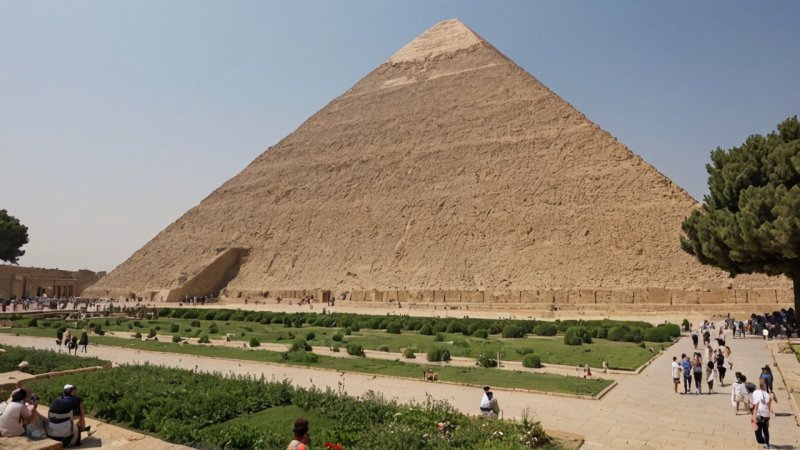The world is home to numerous historical landmarks, each telling a unique story of the past. Among these, the Tomb of Cyrus the Great in Iran and the Great Pyramid of Giza in Egypt stand out not only for their architectural grandeur but also for their historical significance. Both sites are UNESCO World Heritage sites, attracting millions of visitors every year. This article delves into a comparison of these two monumental sites, exploring their history, architectural features, cultural significance, and visitor experiences.
Historical Background
The Tomb of Cyrus the Great, located in Pasargadae, Iran, is the final resting place of Cyrus II, the founder of the Achaemenid Empire. Built in the 6th century BC, it is an important symbol of Persian heritage and is believed to have been constructed by Cyrus himself. The structure reflects the values and beliefs of the Achaemenid dynasty, emphasizing the significance of kingship and divine right.
On the other hand, the Great Pyramid of Giza, built around 2580–2560 BC during the Fourth Dynasty of the Old Kingdom of Egypt, serves as the tomb of Pharaoh Khufu. As the largest of the three pyramids on the Giza plateau, it exemplifies the Egyptians' architectural prowess and their beliefs in the afterlife. The pyramid was originally covered in casing stones that reflected the sun's light, making it shine like a jewel in the desert.
Architectural Features
The architectural design of the Tomb of Cyrus the Great is relatively simple yet striking. It features a rectangular base with a chamber above it, topped by a gabled roof. The structure is constructed from large limestone blocks, with inscriptions in Old Persian and Elamite. The tomb's elevation and the surrounding gardens symbolize the connection between the earth and the divine.
In contrast, the Great Pyramid of Giza is an engineering marvel, originally standing at 146.6 meters (481 feet) tall, making it the tallest man-made structure in the world for over 3,800 years. The pyramid was built using approximately 2.3 million blocks of stone, each weighing an average of 2.5 tons. The precise alignment of the pyramid with the cardinal points showcases the Egyptians' advanced understanding of astronomy and geometry.
Cultural Significance
The Tomb of Cyrus the Great is a symbol of Persian identity and pride. It represents the values of tolerance and respect for diversity that Cyrus embodied during his reign. The site continues to attract those who seek to honor the legacy of one of history's greatest rulers. The tomb is not only a tourist attraction but also a site of pilgrimage for many Iranians.
Conversely, the Great Pyramid of Giza is an enduring symbol of ancient Egyptian civilization. It reflects the Egyptians' beliefs in the afterlife and their dedication to preserving the memory of their pharaohs. The pyramid has inspired countless myths and legends and remains a focal point for studies in archaeology and Egyptology.
Visitor Experience
Visitors to the Tomb of Cyrus the Great can expect a serene experience, surrounded by beautiful gardens that enhance the site's tranquility. The tomb is less crowded than many other historical sites, allowing for a contemplative visit. Guided tours provide insight into the significance of the tomb and the history of Cyrus the Great.
In contrast, the Great Pyramid of Giza is one of the most visited tourist destinations in the world. The site can be bustling with tourists, especially during peak seasons. Visitors can explore the pyramid complex, which includes the Sphinx and other smaller pyramids. Guided tours are available, offering an in-depth understanding of ancient Egyptian history and culture.
Pros and Cons
Pros of the Tomb of Cyrus the Great:
- Less crowded, allowing for a peaceful visit.
- Rich in Persian history and cultural significance.
- Beautiful garden surroundings enhancing the experience.
Cons of the Tomb of Cyrus the Great:
- May lack the grandeur of larger monuments.
- Limited facilities for tourists compared to larger attractions.
Pros of the Great Pyramid of Giza:
- Iconic and world-renowned historical landmark.
- Offers a comprehensive experience with multiple sites to explore.
- Rich in archaeological significance.
Cons of the Great Pyramid of Giza:
- Can be overcrowded, especially during peak tourist seasons.
- Higher commercialization may detract from the historical experience.
Conclusion
Both the Tomb of Cyrus the Great and the Great Pyramid of Giza are extraordinary historical landmarks that offer unique insights into the cultures they represent. The Tomb of Cyrus is a peaceful homage to a significant figure in Persian history, while the Great Pyramid stands as a testament to the grandeur and architectural achievements of ancient Egypt. Depending on your interests—whether you seek tranquility and reflection or the thrill of exploring one of the world’s most iconic structures—both sites offer meaningful experiences. Ultimately, visiting either monument will leave you with a deeper appreciation of our world's rich historical tapestry.






